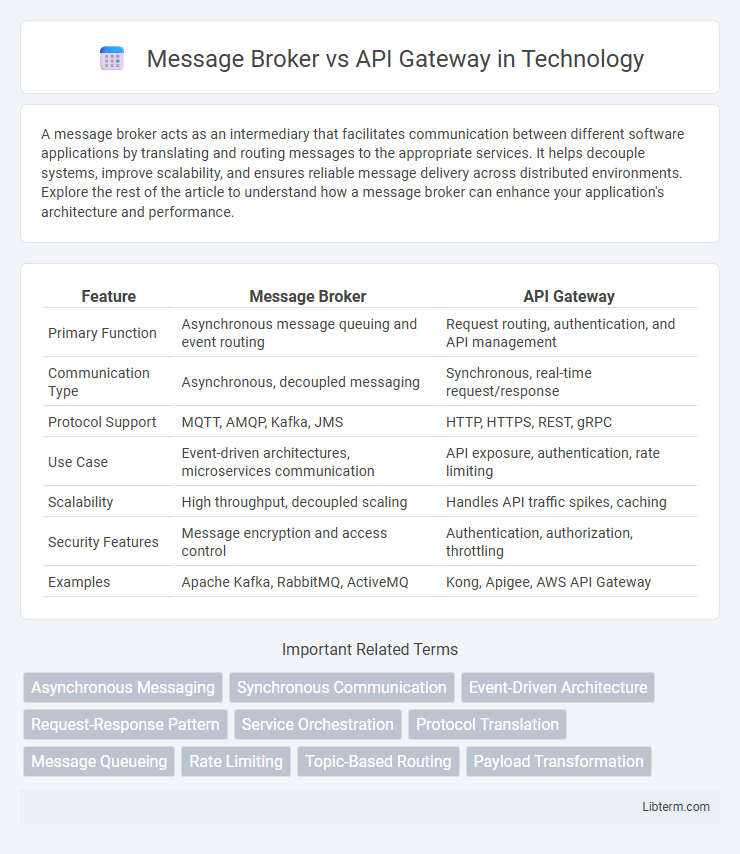A message broker acts as an intermediary that facilitates communication between different software applications by translating and routing messages to the appropriate services. It helps decouple systems, improve scalability, and ensures reliable message delivery across distributed environments. Explore the rest of the article to understand how a message broker can enhance your application's architecture and performance.
Table of Comparison
| Feature | Message Broker | API Gateway |
|---|---|---|
| Primary Function | Asynchronous message queuing and event routing | Request routing, authentication, and API management |
| Communication Type | Asynchronous, decoupled messaging | Synchronous, real-time request/response |
| Protocol Support | MQTT, AMQP, Kafka, JMS | HTTP, HTTPS, REST, gRPC |
| Use Case | Event-driven architectures, microservices communication | API exposure, authentication, rate limiting |
| Scalability | High throughput, decoupled scaling | Handles API traffic spikes, caching |
| Security Features | Message encryption and access control | Authentication, authorization, throttling |
| Examples | Apache Kafka, RabbitMQ, ActiveMQ | Kong, Apigee, AWS API Gateway |
Introduction to Message Brokers and API Gateways
Message brokers are middleware solutions that facilitate communication between distributed systems by translating, routing, and queuing messages to ensure reliable data exchange. API gateways act as intermediaries that manage, secure, and orchestrate API calls between clients and backend services, providing features such as authentication, rate limiting, and request routing. Both components enhance system integration but serve distinct roles: message brokers focus on asynchronous messaging, while API gateways handle synchronous API requests.
Core Functions of Message Brokers
Message brokers primarily facilitate asynchronous communication by decoupling application components through message queuing, ensuring reliable message delivery and load balancing across services. They support various messaging patterns such as publish-subscribe, point-to-point, and request-reply, enabling scalable event-driven architectures. Unlike API gateways that manage synchronous API traffic, message brokers handle complex message routing, transformation, and persistence to enhance fault tolerance and system resilience.
Core Functions of API Gateways
API Gateways serve as a centralized entry point for managing client requests, offering core functions such as request routing, protocol translation, authentication, rate limiting, and load balancing. In contrast to message brokers, which primarily handle asynchronous message queuing and event-driven communication, API Gateways ensure secure, real-time access to backend services through features like API composition, analytics, and caching. These capabilities enable efficient API management by enforcing policies, monitoring usage, and streamlining service interactions in microservices architectures.
Architectural Differences
Message brokers and API gateways serve distinct architectural roles; message brokers enable asynchronous communication by decoupling producers and consumers through message queues or topics, facilitating reliable event-driven architectures. API gateways act as centralized entry points for synchronous client requests, managing routing, load balancing, authentication, and protocol translation to microservices in RESTful or gRPC environments. The decoupling and event-driven nature of message brokers contrasts with the request-response mediation and traffic management focus inherent in API gateway designs.
Communication Patterns
Message brokers facilitate asynchronous communication by decoupling services through message queues and publish-subscribe patterns, enabling reliable, scalable event-driven architectures. API gateways primarily support synchronous request-response interactions, acting as a centralized entry point for RESTful or HTTP-based APIs and managing tasks like authentication, rate limiting, and routing. Choosing between them depends on the system's need for real-time interservice communication versus loosely coupled, event-based messaging patterns.
Scalability and Performance Considerations
Message brokers excel in scalability by facilitating asynchronous communication through decoupled message queues, allowing systems to handle high-throughput workloads and maintain performance under load via load balancing and message persistence. API gateways manage synchronous request routing and often incorporate caching, rate limiting, and load balancing to optimize performance for real-time APIs, but may face bottlenecks under heavy concurrency without proper scaling strategies. For large-scale distributed systems demanding high availability and resilience, message brokers offer superior scalability, while API gateways provide optimized performance for direct client-to-service interactions.
Security Implications
Message brokers and API gateways both play critical roles in securing communication within distributed systems but differ significantly in their security implications. API gateways provide centralized security enforcement by managing authentication, authorization, and TLS termination for incoming API requests, ensuring robust perimeter defense. Message brokers secure asynchronous message exchanges through encryption, access control policies, and message validation, reducing exposure to direct attacks and supporting secure decoupling of services.
Use Cases: When to Use Message Brokers
Message brokers excel in use cases requiring asynchronous communication, such as event-driven architectures, decoupled microservices, and reliable message delivery across distributed systems. They are ideal for scenarios involving high-throughput data streams, complex message routing, or ensuring message persistence and fault tolerance in transaction processing. In contrast, message brokers are preferred when system components operate independently and need loose coupling without immediate synchronous responses.
Use Cases: When to Use API Gateways
API Gateways are essential for managing client requests in microservices architectures, providing functions like request routing, load balancing, authentication, and rate limiting to streamline communication between clients and backend services. They are ideal for scenarios requiring centralized security enforcement, protocol translation, and API aggregation, particularly in complex applications with multiple microservices needing a single entry point. Use API Gateways when exposing RESTful APIs, handling external client traffic, or managing cross-cutting concerns in service-to-service communication.
Choosing the Right Solution for Your Architecture
Message brokers enhance asynchronous communication by decoupling services and enabling reliable message queuing, ideal for event-driven architectures and microservices requiring durability and scalability. API gateways provide a unified entry point for synchronous API requests, managing authentication, rate limiting, and request routing, thus optimizing external client-server interactions. Selecting the right solution depends on your system's communication pattern: prioritize message brokers for complex, event-based workflows and API gateways for controlled, secure API exposure.
Message Broker Infographic

 libterm.com
libterm.com